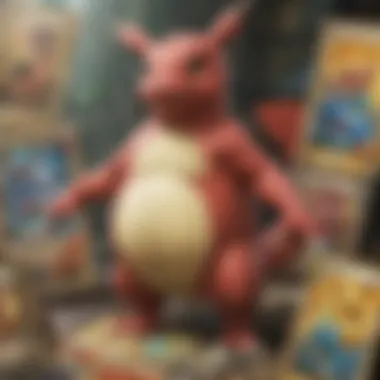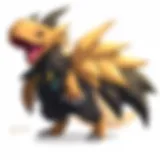Mastering the Art of Selling Pokémon Cards


Intro
In recent years, the world of Pokémon cards has transformed into a thriving market, where both nostalgic collectors and trend-savvy investors converge. As the popularity of Pokémon has surged, driven by fresh game releases, TV series, and the buzzing online community, selling Pokémon cards has become much more than just a hobby for many. Whether you're a seasoned card enthusiast or just cleaning out a childhood collection, understanding the nuances involved in selling Pokémon cards is essential.
The intricacies of this market can be akin to navigating a dense forest, full of opportunities yet with tricky paths that can lead to dead ends. Here, we’ll illuminate the key points that will guide you smoothly through the landscape of buying and selling Pokémon cards. From determining the value of what you own to understanding current market trends, this guide aims to equip you with all the slice-and-dice knowledge you need.
Here’s a sneak peek at what’s to unfold:
- Insights on valuation methods and how to recognize genuine demand.
- A look at online platforms for selling, along with pros and cons.
- Tips on crafting effective sales strategies that hit home.
- Trends currently shaping the Pokémon card marketplace.
By the end of this journey, you’ll be better positioned to capitalize on your Pokémon cards, ensuring that each sale not only brings in money but also keeps the process smooth and enjoyable.
Understanding the Value of Pokémon Cards
When debating the ins and outs of selling Pokémon cards, comprehending their value is paramount. Without an intimate grasp on what contributes to a card's worth, sellers might find themselves shortchanged or overpricing their treasures, leading to missed opportunities. Understanding the value of Pokémon cards effectively sets the entire foundation for a successful selling strategy.
There are several elements that mix together to create the final value of a given card. Factors like rarity, condition, and market demand aren't just trifles; they are the lifeblood of card pricing. Knowing how each of these factors interplay will not only enhance a seller’s chances of getting a fair price but could also reveal hidden gems lurking in one's collection.
Factors Influencing Card Value
Rarity
Rarity is often considered the heavyweight champion among factors impacting card value. When a card is produced in limited quantities, it automatically attracts collectors. The more elusive a card is, the more value it potentially commands. Cards such as the holographic Charizard from the Base Set are legendary largely because they are scarce, making them hot commodities.
A key characteristic of rarity is its role as a catalyst for competitive pricing. Sellers often find themselves in bidding wars for rare cards, pushing the final selling prices to stratospheric levels. However, the downside can be that again, rarity doesn't guarantee a high price; it has to be a card that's also in demand.
Condition
The condition of a card plays no small role in defining its worth. A mint-condition card can fetch significantly more than one that has seen better days. Factors like scratches, creases, or faded colors can drastically reduce the card's market value. Collectors usually want cards that are as close to perfect as possible.
Sellers should always highlight the condition in their listings, making note of any imperfections. Knowing grading systems can also offer insight into potential selling prices. Cards graded by organizations like PSA (Professional Sports Authenticator) are often valued higher, so understanding these grading nuances is beneficial in this game.
Market Demand
Market demand operates much like the tide; it ebbs and flows based on collector interest and current trends. A card may skyrocket in value with the release of a new Pokémon game or if a certain Pokémon makes a splash in the franchise. Sellers need to keep their fingers on the pulse of the market to maximize potential earnings.
A characteristic of market demand is that it’s often influenced by broader trends within the Pokémon universe. If a card was once highly sought after, it might lose its luster as new cards capture attention. Therefore, sellers should consistently monitor market movements and adapt their strategies accordingly.
Identifying High-Value Cards
Legendary Pokémon
When it comes to identifying high-value cards, few categories shine like the legendary Pokémon. These creatures are not just powerful; they carry with them a sense of accomplishment for collectors and players alike. Cards featuring legendary Pokémon often see higher price tags because they invoke nostalgia and excitement.
These cards can stand out in a collection due to their unique features like foiling, special illustrations, and often a lower print run. Their appeal, both for playing and collecting, makes them a popular choice for sellers looking to cash in on significant value.
Promotional Cards
Promotional cards represent another high-value segment worth exploring. These cards are typically limited-edition releases meant to promote events, movies, or anniversaries. Their unique nature frequently makes them desirable among collectors who want to own a piece of Pokémon history.
A notable feature of promotional cards is that they often carry unique designs or attributes that set them apart from standard cards. While they might not always reach the top levels in auctions, their collectible nature can sometimes yield surprising profits, especially if they’re in good condition.
First Editions
First edition cards hold a singular place in any collection. The very fact that they were the first batch produced grants them a certain prestige. Collectors are often willing to pay a premium for first edition cards, especially those that are in good condition.
These cards usually feature a distinct “First Edition” stamp, which confirms their status. While not all first edition cards are created equally, the distinct markings help sellers to position these cards strategically. As some of the most sought-after cards in Pokémon history, having first editions in one’s inventory can really elevate a seller’s standing in the market.
"Rarity, Condition, and Market Demand are the holy trinity of Pokémon card valuation."
Researching the Current Market Landscape
Understanding the landscape of selling Pokémon cards is like reading a map before heading out on an adventure - it gives direction. Researching the current market landscape is crucial, as it helps sellers gauge where to position their products, how to price them, and to make sense of buyer behaviors. Especially in a dynamic market like Pokémon cards, knowing the trends can mean the difference between a fast sale and a collection gathering dust.
Analyzing Recent Sales Trends
Sales Platforms
Sales platforms are the venues where transactions take place, and each has its own flavor. eBay, for instance, offers a vast selection, spanning from common cards to ultra-rare finds. It’s like an online bazaar where prices can swing dramatically from day to day. This wide reach makes it a popular choice among sellers wanting to find a buyer for pretty much any card.
While eBay allows flexibility in pricing and a broad audience, it’s essential to account for the selling fees that can nibble away at profits.
Price Fluctuations
Price fluctuations in the Pokémon card market can feel like a wild rollercoaster ride; they can soar high one moment and plummet the next. Keeping an eye on these shifts helps sellers adapt their pricing strategies. Many sellers rely on specific metrics like recent sales on platforms or trends from dedicated Pokémon forums. A key characteristic is that these fluctuations often depend on seasonal events, card popularity, and even nostalgia factors. While riding the wave of these price changes can potentially increase profit margins, it poses risks to those unprepared for sudden changes.
Popular Cards
The term popular cards refers to those that collectors and players just can’t seem to get enough of. Cards like the Charizard are household names among fans. Their desirability makes them prime candidates for selling, often commanding higher prices. This popularity feeds into a broader trend; understanding what makes a card hot at any given moment can significantly benefit sellers. Unlike obscure cards that may sit on the shelves, popular cards can practically fly off them, allowing for quicker turnover. However, staying updated on fluctuating popular cards requires diligence, as fads come and go, and today’s treasure may be tomorrow’s forgotten relic.


Trailing the Competition
Competitor Pricing
Competitor pricing sheds light on the market standards. It’s imperative to assess what other sellers charge for similar cards. For instance, observing the prices on TCGPlayer and comparing them with those on Facebook Marketplace can unveil insights into what buyers are willing to part with their hard-earned cash for. The key characteristic of watching competitor pricing is the ability to offer competitive rates while still aiming for a profit. Understanding these trends helps maintain relevance in such a fickle market. An advantage of keeping an eye on competitors is that it fosters strategic pricing, yet there’s always a risk: if one underestimates competitors, they may lose out, missing crucial market opportunities.
Unique Selling Points
Identifying a card’s unique selling points can set it apart from the competition. Perhaps it includes lovely artwork or carries historical significance among fans. These elements can play a pivotal role in marketing efforts and buyer interest. A significant benefit of focusing on unique selling points is that they allow sellers to create compelling narratives around their products, making them more alluring to potential buyers. However, if a seller doesn’t effectively communicate these points, potential buyers might overlook them.
Innovative Marketing Strategies
In the crowded Pokémon market, innovative marketing strategies can elevate a seller from just another name in the crowd to the go-to option for collectors. This might involve utilizing social media platforms like Instagram to showcase rare cards, creating engaging content that resonates with fans. The key characteristic here is adaptability—being able to pivot strategy based on what’s trending in the community. The main advantage of innovative strategies is that they can build strong community ties, fostering trust among potential buyers. However, the challenge is being consistent; without regular engagement, even the best ideas can fade away, making it vital for sellers to stay on the ball.
Preparing for Sale
When it comes to selling Pokémon cards, getting everything ready before actually putting them on the market is absolutely crucial. This step can greatly influence your overall success, whether you're a seasoned seller or a newcomer looking to profit from your childhood collection. The right preparation doesn't just boost your confidence but also can significantly increase the perceived value of your cards.
Condition Assessment
This part is all about figuring out the state of your cards. Condition assessment literally sets the stage for how your Pokémon cards will be viewed by potential buyers.
Cleaning Techniques
Cleaning your cards isn’t just a nice-to-have; it’s often a must. Many sellers overlook this aspect, believing that even a little dust doesn't matter, but in reality, a card in pristine condition can command a higher price.
- Key Characteristic: Thorough cleaning can enhance the appearance, making it visually more appealing.
- Benefits: It removes dirt, grime, or fingerprints that can detract from the card's value.
- Unique Feature: Not all cleaning methods are suitable! You should avoid using harsh chemicals or soaking cards in any liquid — it might do more harm than good.
The right cleaning product like a microfiber cloth works wonders. It's gentle enough to not scratch the surface and helps maintain value.
Grading Systems
Understanding grading systems introduces a level of professionalism to your selling game. Everyone values their cards differently, but grading gives a standardized method for assessing worth.
- Key Characteristic: Cards are evaluated based on their condition and rated on a numerical scale.
- Benefits: This can make your cards more appealing to buyers, as they can be sure they know what they’re getting.
- Unique Feature: Different grading companies might have varying standards; typically, PSA and Beckett are highly regarded. The drawback? Grading can be quite an expensive and time-consuming process, so you'll need to weigh the benefits against the costs.
Preservation Tips
Once you’ve cleaned and graded, you want to ensure your cards stay in top shape. Preserving your cards extends beyond just keeping them safe; it's a fundamental aspect of sales preparation.
- Key Characteristic: Proper preservation techniques can protect your cards from environmental damage.
- Benefits: Using sleeves or hard cases can prevent bending and fading, thereby maintaining value.
- Unique Feature: Archival-quality storage options are capable of safeguarding against UV light, which can cause discoloration over time.
Though it might take some effort to set up the right conditions, the pay-off in the long-term worth is often worth it.
Creating a Comprehensive Listing
An eye-catching listing can make all the difference in catching a buyer's attention. You want to convey every important detail about your cards, ensuring potential buyers know exactly what they’re getting into.
Photographic Documentation
Using high-quality photos in your listing transforms a simple entry into a visually engaging experience. It’s one of the most effective ways to draw in buyers and can set your card apart from others.
- Key Characteristic: Good lighting and resolution enhance clarity, allowing details like edges or surfaces to shine through.
- Benefits: It builds trust; buyers can clearly see what they are purchasing.
- Unique Feature: Consider including multiple angles and close-ups of any defects. While it may seem counterintuitive, transparency pays off.
Descriptive Details
Well-crafted descriptions serve to complement your photographs, providing context that can not be captured visually. This part is where you sell the appeal of each card while laying out your cards’ legitimacy.
- Key Characteristic: Detailed descriptions incorporate vital stats like series, edition, and rarity.
- Benefits: Clear and engaging writing helps buyers feel a connection to the card and informs them what makes it special.
- Unique Feature: Highlighting any unique features or story associated with the card often makes it more attractive. Just be cautious not to overstate its worth inaccurately!
Listing Platforms
Choosing the right playground for your cards is equally as important as the cards themselves. You wouldn’t show up to a championship match without knowing the field, right?
- Key Characteristic: Some platforms like eBay cater specifically to collectors, while others like Facebook Marketplace may offer more local options.
- Benefits: Knowing where to list can also drastically affect your exposure and selling price.
- Unique Feature: Consider the fees associated with each platform. While one may seem appealing, the total cost might diminish your profits.
Sales Platforms and Methods
When it comes to selling Pokémon cards, choosing the right platform can vastly affect your overall experience and profit margins. In today’s digital age, both online marketplaces and in-person sales options provide unique benefits and challenges. Understanding how to navigate these channels is crucial for a successful transaction.
Online Marketplaces
The backdrop of online trading offers sellers a far-reaching audience. As a Pokémon enthusiast looking to maximize profits, gravitating towards platforms that cater specifically to collectible trading can be transformative.
eBay
eBay is often considered the gold standard for selling Pokémon cards online. What sets eBay apart is its extensive reach; it's a marketplace teeming with buyers from around the globe. One significant characteristic of eBay is its auction-style listings, where sellers can set starting bids that might lead to profitable bidding wars.
Advantages of using eBay:


- Widespread visibility: A large user base means better chances of selling cards quickly.
- Flexibility: You can auction or set fixed prices, giving you control over sale terms.
- Research capabilities: Access to completed listings helps sellers gauge the market value of specific cards.
However, there are drawbacks. eBay charges sellers fees that can nibble at profits. Additionally, sorting through countless listings to find your card can be overwhelming.
TCGPlayer
TCGPlayer is tailored for trading card enthusiasts, making it a fantastic choice for selling Pokémon cards. What stands out on this platform is the streamlined process of listing products. Sellers can quickly upload their inventories, and the site comes with a price guide that reflects live market data.
Benefits include:
- Target audience: Users are typically serious buyers and collectors, enhancing the likelihood of a sale.
- Pricing advantages: Prices are guided, so sellers can make informed decisions based on current trends.
On the flip side, TCGPlayer does have certain limitations. Sellers may have to navigate fees based on their sales volume, and the site lacks some of the visibility that broader platforms like eBay possess.
Facebook Marketplace
Facebook Marketplace has gained traction and could be an interesting option for selling Pokémon cards. With most people already on the platform, it’s convenient to list cards without the hassle of creating a new account elsewhere. Important for sellers is the direct interaction with potential buyers, allowing for more straightforward negotiations.
Key features include:
- Community-oriented: You can engage with local buyers, avoiding shipping hassles.
- Familiarity: Many users are already comfortable with the interface, which may facilitate quicker sales.
However, sellers should be cautious. Without built-in protections for transactions, there’s a potential for scams or misunderstandings to arise. Additionally, the lack of an established pricing framework can lead to underpricing or overpricing.
In-Person Sales Options
For those who enjoy direct interaction, in-person sales can be an enriching experience. These face-to-face opportunities allow sellers to engage with fellow collectors, showcase cards physically, and often receive immediate payment.
Local Card Shops
Visiting local card shops is a solid strategy to consider when selling Pokémon cards. Shops often cater to collectors and are interested in buying inventory directly. One major advantage is the instant feedback you can receive about your cards’ value.
Pros include:
- Accessibility: It’s often convenient to walk in, and many shops buy cards right off the bat.
- Trust Factor: Established shops have a reputation to uphold, which adds a layer of security to transactions.
The downside could be that shop owners may offer lower prices than what you might find on competitive markets. They need to keep the margin to make a profit too.
Swap Meets
Swap meets present a casual atmosphere for trading and selling cards, where enthusiasts gather to buy, sell, or trade in a community setting. This environment can yield fruitful connections with fellow Pokémon fans.
Advantages include:
- Networking: You get to meet potential buyers and other collectors face to face.
- Less competition: Swap meets are usually less crowded than online options, making it easier to chat with interested parties.
On the downside, the nature of swap meets can lead to barter-style negotiations which might not always result in the best prices for sellers.
Conventions
Participating in conventions offers a high-energy space filled with like-minded individuals, making it a prime spot for selling Pokémon cards. Conventions often have dedicated trading areas, where the excitement can enhance the sales process.
Major benefits include:
- Environment: The festive atmosphere is encouraging and could lead to quicker sales.
- Focused audience: Attendees are often specific to card gaming, which increases the chance of reaching serious buyers.
However, preparation for conventions can be cumbersome. Booth fees or tickets could eat into profits, and there's also the need to transport your inventory safely.
In summary, selecting the right sales platform or method is pivotal in the journey of trading Pokémon cards. Whether you choose online marketplaces for their reach or prefer in-person options for the face-to-face connection, understanding each platform's nuances can lead to more informed selling decisions.
Negotiating Sales
Negotiating sales is a critical component of successfully selling Pokémon cards. This part of the process can make or break your profits, and it demands attentiveness to various factors that influence both pricing and buyer interest. For sellers, knowing how to set initial prices and negotiate effectively can lead to more successful transactions and satisfied buyers.
Setting Initial Prices
Research-Based Pricing
Research-based pricing involves collecting data on recent sales and market trends to determine a fair price for Pokémon cards. This aspect is pivotal because it helps you avoid underselling or overpricing your cards. Many buyers will do their homework, too, so having a research-backed price can instill confidence in the buyer.
A key characteristic of this approach is its reliance on empirical data rather than gut feelings. Sellers can utilize platforms like eBay or TCGPlayer to observe the selling prices of similar cards. This makes it a popular choice, as it aligns your prices with what the market is currently bearing.
The unique feature of research-based pricing is its adaptability. Sellers can adjust prices as market conditions shift, informed by data gathered from recent sales. However, it can come with some disadvantages; in a volatile market, what was once considered a fair price can quickly become outdated. Thus, the seller must be vigilant and informed.
Negotiation Tips
Negotiation tips are immensely valuable for enhancing your sales technique. Whether you’re selling rare holographic cards or more common ones, knowing how to navigate conversations can lead to a more profitable outcome. The key characteristic of effective negotiation is the ability to communicate your card's value convincingly.


This strategy is beneficial as it can help you secure a sale at a price that makes you happy while also keeping the buyer feeling like they got a good deal. A unique feature of good negotiation is the blend of hard and soft skills, where you maintain assertiveness while also being personable. It allows you to build rapport, which can lower buyer anxiety and lead to smoother transactions.
However, if you fail to establish that balance, you might run the risk of creating tension, which can ultimately scare buyers away.
Understanding Buyer Psychology
Understanding buyer psychology is crucial to tailoring your negotiation approach. This involves recognizing how buyers think, what motivates them, and what can deter them from purchasing a card. A central aspect of this understanding is knowing that buyers often attribute value based on emotional connection, rarity, and the reputation of the seller.
By tapping into buyer psychology, you can adjust your strategy to appeal to their motivations. For instance, if you’re aware that someone is particularly passionate about collecting Legendary Pokémon, you can highlight aspects of the card or its background that may resonate more deeply with them.
The unique feature of this understanding is its fluidity; it can be modified continuously based on interactions with different buyers. While being attuned to buyer psychology can increase your influence during negotiations, it may also require significant emotional intelligence. Misjudging a buyer's motivations can come back to bite you.
Closing the Deal
Payment Methods
Payment methods are a substantial part of concluding your sale smoothly. Knowing the right options for both you and your buyer can set the stage for a transaction that feels secure and appropriate. Common payment platforms include PayPal and Venmo, which offer ease of use and familiarity, especially among younger collectors.
A critical characteristic of diverse payment methods is their ability to accommodate various buyer preferences, encouraging more transactions. This variety is beneficial because it enhances the likelihood of closing a deal—if a buyer can't use their preferred payment method, they might reconsider.
However, each method also has its disadvantages; for example, some payment types come with fees, which could cut into your profits. If you are not careful, this could disrupt a transaction chain you’ve been working hard to nurture.
Shipping Considerations
Shipping considerations are not to be taken lightly when wrapping up a sale. The condition in which a card arrives can significantly impact buyer satisfaction and influence future transactions. A seller should take into account whether they would prefer standard or expedited shipping and consider the costs involved.
A standout characteristic of effective shipping strategies is transparency; clearly stating your shipping methods and expectations will foster trust. This can be a major factor in closing the deal since buyers appreciate knowing exactly when their items will arrive.
However, shipping can be a double-edged sword. While a seller might opt for the cheapest option, it could lead to delays or damage to the cards. This’s a gamble; avoiding logistical mishaps is often more important than squeezing every penny.
Transaction Safety
Transaction safety is paramount when it comes to negotiating and closing the sale of Pokémon cards. In an age where online scams are prevalent, ensuring a secure transaction can build trust with your buyers and lead to repeat purchases. A key feature of transaction safety is using escrow services or secure payment platforms that protect both the seller and the buyer.
This isn’t just a beneficial attribute; it’s almost a necessity in today’s market. It can serve as an ironclad assurance to your buyers, elevating their comfort level significantly. However, implementing such safety measures can create additional steps within the sales process, which might deter some less experienced sellers.
Always prioritize transaction safety to cultivate a trustworthy reputation in the Pokémon card market.
Post-Sale Considerations
After sealing the deal, the journey doesn’t just come to a halt. Post-sale considerations are essential for anyone looking to maintain a thriving Pokémon card selling enterprise. Engaging in these aspects shows professionalism and builds trust within the community.
Feedback Collection
Importance of Ratings
In any online marketplace, ratings are like the gold stars of yesteryears. They demonstrate reliability and offer proof that you’re not just another fish in the sea. A high rating often attracts more buyers, creating a snowball effect that can enhance your sales. Sellers with good ratings tend to receive higher offers, as potential buyers feel more secure.
The unique quality of ratings lies in their power to almost act as a currency. The better your ratings, the more credibility you gain, which can lead to easier negotiations in future sales.
Building Reputation
Building a reputation within the Pokémon trading community is akin to cultivating a garden; it requires care, consistency, and a dash of patience. A solid reputation not only brings repeat business but also positions you as a go-to seller when it comes to valuable cards. Sellers with a strong reputation are often sought after, giving them leverage in negotiation.
It’s noteworthy how a reputable status can even speed up sales. Buyers are more inclined to purchase from someone they recognize and trust. However, a minor hiccup in your reputation can take time to mend, which is a disadvantage when the market moves fast.
Handling Disputes
Handling disputes effectively is perhaps one of the unsung heroes of post-sale activities. Addressing issues promptly and diplomatically can prevent minor misunderstandings from snowballing into major headaches. This capability shows buyers that you care, ultimately leading to better customer satisfaction.
A significant advantage of mastering this skill is that it minimizes negative feedback, which is crucial for maintaining your ratings. Still, every dispute might not go as planned and could result in negative sentiment. Acknowledging that some issues can’t be fixed may be tough, but it's part of running a responsible selling enterprise.
Future Selling Strategies
Moving on to future selling strategies is important once the sales transactions have wrapped up. Keeping tabs on the evolving market is vital for long term success.
Market Monitoring
Market monitoring helps you keep your finger on the pulse of the Pokémon card trade. By tracking trends, you can understand what cards are rising in popularity and which ones are falling flat. This way, you might want to adjust your sale strategies accordingly.
Highlighting the characteristic of constant vigilance, you can spot opportunities that others might overlook—perhaps snagging a rare card at a low price before the hype escalates. On the flip side, over-analyzing market movements might lead to analysis paralysis, preventing timely decisions when the market heats up.
Adapting to Trends
Adapting to trends is crucial; it’s similar to surfing the waves. You don’t just hop on a board and expect to ride—one needs to gauge the swell. If you can identify trends, you can adjust your selling tactics, ensuring that your inventory aligns with what’s currently hot. This flexibility can provide an edge over less responsive competitors.
However, jumping too swiftly into every trend can be a double-edged sword. It can often lead to financial missteps if trends fade away as quickly as they emerged, leaving you with merchandise that nobody wants.
Expanding Inventory
Expanding your inventory judiciously is like adding more strings to your bow. By offering a diverse range of cards, you increase your chances of attracting various buyers. Collectors are always on the lookout for something unique, so having a rich selection can make you a favored seller.
Yet, expanding inventory can come with its challenges. It requires investment and knowledge about what types of cards have the potential to sell. Bringing in too many items too fast could dilute your focus, making it harder to manage sales effectively.
In summary, post-sale considerations encompass feedback collection, reputation building, and the handling of disputes, while future selling strategies must focus on market monitoring, adapting to trends, and judiciously expanding inventory. Each element plays a pivotal role in ensuring ongoing success in the Pokémon card selling game.







